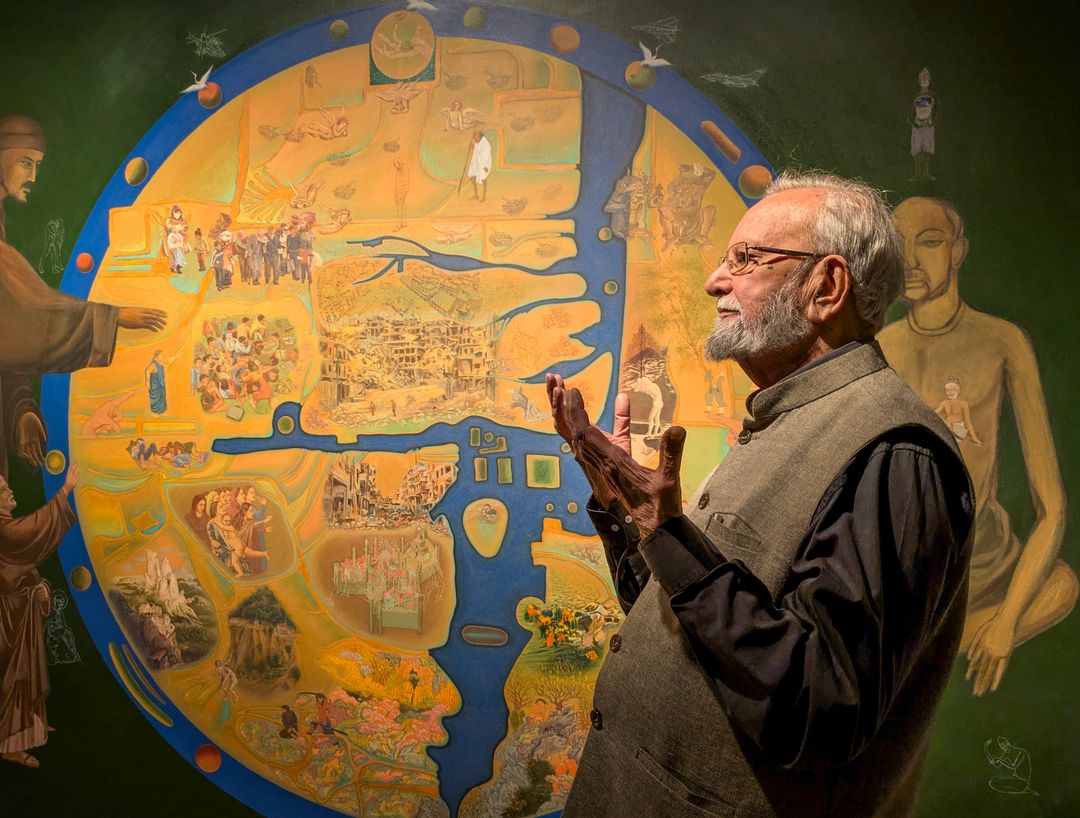
New Delhi, March 4: At 88, Gulammohammed Sheikh continues to illuminate the art world with his profound reflections on human crises, communal strife, and philosophical musings. These themes are vividly brought to life in "Of Worlds Within Worlds," an expansive retrospective presented by the Kiran Nadar Museum of Art (KNMA) in New Delhi.
The exhibition, which runs until June 30, features over 190 pieces showcasing Sheikh's extraordinary six-decade-long artistic journey. Through diverse mediums—including gouache, oils, pen and ink drawings, graphic prints, and digital collages—Sheikh invites viewers to explore a complex tapestry of memories, cultural dialogues, and socio-political commentary.
Early Life and Artistic Evolution
Sheikh’s formative years in Surendranagar, Gujarat, greatly influenced his initial artistic expressions. His early works vividly capture local imagery such as horses and tongas, later evolving into elaborate landscapes and intricate urban vistas, demonstrating his mastery of bold impasto techniques.One pivotal work, "Returning Home After a Long Absence" (1969-73), marked Sheikh’s innovative approach of blending disparate cultural images into cohesive narratives. The collage-like quality of this piece became a defining element of his later works, merging personal memory with broader societal contexts.
Artistic Reflections on Political and Social Turmoil
Sheikh’s art often mirrors the complexities of social and political upheaval. "Speechless City" (1975) powerfully conveys his response to the Emergency in India, portraying a bleak, deserted city dominated by ominous black dogs and crows—a metaphorical critique of suppressed democratic rights.In "The Speaking Street" (1981), Sheikh captures the lively chaos of an Indian street, inspired by his experiences in Baroda. Conversely, his piece "City for Sale" (1981-84) poignantly portrays urban turmoil during a period of communal violence, bringing to life the suffering and resilience of people amidst crisis.
"I responded to what was going around; I didn't paint everything. There are certain things which could be painted and certain things you can't paint," Sheikh explained, emphasizing art’s selective yet powerful engagement with reality.
Icons of Peace: Kabir and Gandhi
Throughout his oeuvre, Sheikh frequently references two iconic symbols of peace—mystic poet Kabir and Mahatma Gandhi. His acclaimed "Kahat Kabir" series, initiated in 1996, integrates Kabir’s teachings into visual forms, advocating a philosophy of unity, non-violence, and humanism amid communal unrest.Similarly, Gandhi appears repeatedly in Sheikh’s creations, notably in "Ahmedabad - The City Gandhi Left Behind" (2015-16). This impactful painting reflects Sheikh’s deep anguish over the 2002 Gujarat riots, vividly rendered in shades of grey with an evocative central image of a burning autorickshaw. Integrated Google Maps imagery uncovers the intimate details of life within Ahmedabad, punctuated by symbols of Gandhi’s personal items—his glasses, watch, slippers, and utensils.
Kabir and Gandhi also feature prominently alongside global cultural icons, including Frida Kahlo, Leonardo da Vinci, Rabindranath Tagore, M.F. Husain, and Vincent Van Gogh, in recent works like "Kaarawaan" (2019-2023) and "Dus Darwaze" (2019-2024).
Sheikh's Philosophy of Artistic Struggle
For Sheikh, both life and art involve relentless struggle. He eloquently describes the act of painting as an ongoing quest to interpret experiences visually: "In life, it is just a blank truth; art is not like that. It gives you multiple views of the same situation, and if you look at it repeatedly, different meanings emerge.""Of Worlds Within Worlds" thus serves as more than just an exhibition—it is a powerful testament to Sheikh's lifelong endeavor to explore, understand, and artistically respond to the multifaceted realities of existence.
The exhibition at KNMA in New Delhi will remain open to visitors until June 30, 2025.
Last updated by a enewsx: